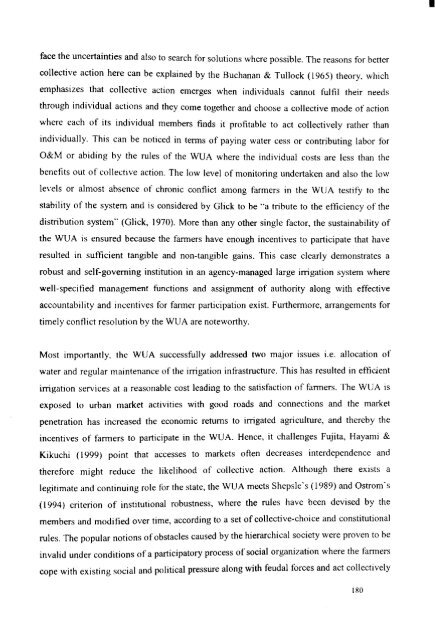Water Users Association and Irrigation Management - Institute for ...
Water Users Association and Irrigation Management - Institute for ...
Water Users Association and Irrigation Management - Institute for ...
Create successful ePaper yourself
Turn your PDF publications into a flip-book with our unique Google optimized e-Paper software.
•<br />
face the uncertainties <strong>and</strong> also to search <strong>for</strong> solutions where possible. The reasons <strong>for</strong> better<br />
collective action here can be explained by the Buchanan & Tullock (1965) theory, which<br />
emphasizes that collective action emerges when individuals cannot fulfil their needs<br />
through individual actions <strong>and</strong> they come together <strong>and</strong> choose a collective mode of action<br />
where each of its individual members finds it profitable to act collectively rather than<br />
individually. This can be noticed in terms of paying water cess or contributing labor <strong>for</strong><br />
O&M or abiding by the rules of the WUA where the individual costs are less than the<br />
benefits out of collective action. The low level of monitoring undertaken <strong>and</strong> also the low<br />
levels or almost absence of chronic conflict among farmers in the WUA testify to the<br />
stability of the system <strong>and</strong> is considered by Glick to be "a tribute to the efficiency of the<br />
distribution system" (Glick, 1970). More than any other single factor, the sustainability of<br />
the WUA is ensured because the farmers have enough incentives to participate that have<br />
resulted in sufficient tangible <strong>and</strong> non-tangible gains. This case clearly demonstrates a<br />
robust <strong>and</strong> self-governing institution in an agency-managed large irrigation system where<br />
well-specified management functions <strong>and</strong> assignment of authority along with effective<br />
accountability <strong>and</strong> incentives <strong>for</strong> farmer participation exist. Furthermore, arrangements <strong>for</strong><br />
timely contlict resolution by the WUA are noteworthy.<br />
Most importantly, the WUA successfully addressed two major issues i.e. allocation of<br />
water <strong>and</strong> regular maintenance of the irrigation infrastructure. This has resulted in efficient<br />
irrigation services at a reasonable cost leading to the satisfaction of farmers. The WUA is<br />
exposed to urban market activities with good roads <strong>and</strong> connections <strong>and</strong> the market<br />
penetration has increased the economic returns to irrigated agriculture, <strong>and</strong> thereby the<br />
incentives of farmers to participate in the WUA. Hence, it challenges Fujita, Hayami &<br />
Kikuchi (1999) point that accesses to markets often decreases interdependence <strong>and</strong><br />
there<strong>for</strong>e might reduce the likelihood of collective action. Although there exists a<br />
legitimate <strong>and</strong> continuing role <strong>for</strong> the state, the WUA meets Shepsle's (1989) <strong>and</strong> Ostrom's<br />
(1994) cri terion of institutional robustness, where the rules have been devised by the<br />
members <strong>and</strong> modified over time, according to a set of collective-choice <strong>and</strong> constitutional<br />
rules. The popular notions of obstacles caused by the hierarchical society were proven to be<br />
invalid under conditions of a participatory process of social organization where the farmers<br />
cope with existing social <strong>and</strong> political pressure along with feudal <strong>for</strong>ces <strong>and</strong> act collectively<br />
IRO
















